 |
||||||||||
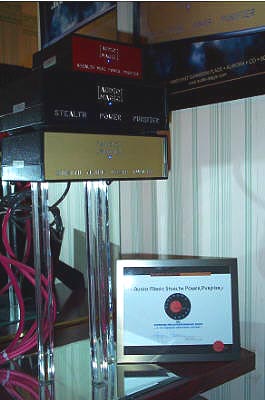 |
 |
|||||||||
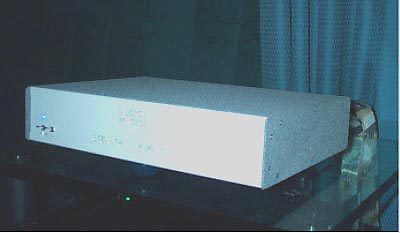 |
||||||||||
Audio Magic was showing their line-up of Stealth Power Purifiers with our Blue Moon Award [above] and the just-reviewed Kukama Stealth DAC [lower right] in the final granite-fleck finish. Speakers were Green Mountain Continuum 3 ($6,700/pr) first-order designs. |
||||||||||
| Those use a unique adjustable cast-marble minimum-diffraction housing for the hi/mid transducers and a triple-wall woofer cabinet. Talk about a Houdini-esque disappearance act. All airy spaciousness, no hint of speaker localization. This seems to be a very serious effort mandating close encounters of the 9½ Weeks kind. More pix of the Continuum 3 in Green Mountain's own listing. Remember my Audio Analogue musings about getting into multi-channel as a small two-channel company? Answering such ruminations by way of pointing in a different direction, Avalon Acoustics entered the professional studio monitor market with their new $4,995/pr Mixing Monitor that sports their trademark faceted baffle. |
||||||||||
| Merely hinting at such compound angles cost Silverline's Alan Yun a lawsuit threat resulting in a redesign of his Sonata and Sonatina models some time ago. With a concave 1" ceramic dome tweeter and matching 7" woofer, in-room bass response is given as 46Hz, sensitivity as 87dB and impedance as 6/5.5 nominal/minimal. Looking at the published polar response, the Mixing Monitor ought to excel at super-accurate imaging and high resolution. While I tend to believe that mastering and listening for pleasure demands different things of speakers, admirers of highly focused precision will probably find much to enjoy here. Dimensions are a modest 18" high by 8.5 wide and 10.5" deep. Eduardo de Lima of AUDIOPAX had two new products, the Stereo 88 power amp ($5,970) and Model 5 preamp ($3,970). The former is based on the Model 88 monos I own and cleverly converts the twin-amps-in-one-monaural-chassis into a half-powered 15-watt stereo version that retains the unique TimbreLock feature and, outside of the doubled-up terminals on the rear, looks indentical to the monos. |
 |
|||||||||
| The preamp is a choke-loaded MOSFET design with RF remote volume, 180V outboard power supply, 5 inputs (including 1 direct) and two fine-calibration gain controls in addition to the master volume. The other rotary front panel dials select inputs and record-out routing. By adjusting the gain structure of the Model 5 to its chosen amplifier, performance can be optimized just like the sliding/offset bias of the TImbreLock controls the amp/speaker interface on Eduardo's amps. Mastering engineers with multiple gain stages in series have long since known that fine-tuning gain at each stage has profound implications on the final sound and allows calibration for very specific results. As if that weren't enough, de Lima also showed a prototype new speaker, a 2-way monitor atop a separate sealed woofer cabinet with response and load behavior idealized for high-output impedance, low damping factor SET amplifiers. The sound in this room? Elegant, refined, married to the very essence of music. Positive Feedback's Clark Johnson raved about it in the elevator as a must-hear attraction. He was somewhat disappointed that not only had I already been to it but actually "discovered" AUDIOPAX many years ago. Avantgarde Acoustic's engineering whiz Matthias nearly lost his life with a fall a few months back that causes an indented skull fracture. He was his usual life-embracing self in Las Vegas but had missed the A-train to the Great Beyond by a mere 10 minutes according to his surgeon. He, Holger Fromme and Bob Visintainer of the New York store manned the Alexis Park DUO and SOLO exhibits and used the firm's brand-new 5pi. That stands for both preamp/integrated as well as the value pi used to calculate circles, spherical horns and other mathematical arcana while the preceding 5 points at the number of active devices in the signal path. Despite an acquaintance's prediction that "these Germans" loved Techno and were thus ill-equipped to set up their own speakers for a proppa High-End dem, this minimalist rig fronted by Arcam's FMJ Ring-DAC player sounded very good (i.e. set up well which is important with the bigger horns). Proof positive that loving Techno and being an exacting audiophile are not mutually exclusive moronic oxen! |
 |
|||||||||
 |
||||||||||
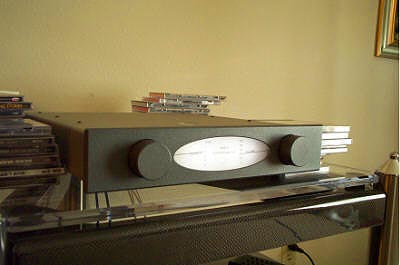 |
||||||||||
 |
||||||||||
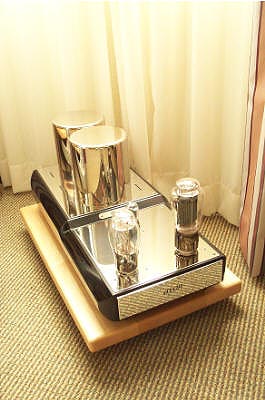 |
||||||||||
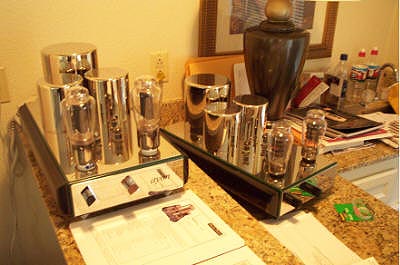 |
||||||||||
 |
||||||||||
As an outlet for AVVT's Vaic tubes, Ayon Audio's triode amplifiers cut a dapper Euro profile and included the entry-level Sunrise quadruple-input 32B integrated with 5687 driver and 12AU7 input tubes for 25wpc output power and tastefully lacquered green wooden cheeks [upper left]. The 52B Classic monoblocks deliver 30 watts of SET magic from a pair of 52Bs and use an 8B and 6SN7 for driver and input duties [upper right]. The Ayon Dragon is a single-driver full-range design augmented by a 15-inch woofer in an optimized airflow cabinet [right]. Represented by Lumen White fame Acoustic Dreams in the US, these products oozed class purely on looks alone. Taking their Swiss/German heritage into account, one is tempted to predict great sonic qualities as well. Predict? When I stopped by, the representatives were engrossed in wrapping up a prior demo with some business matters. I mosied on pressed for time without laying an ear on these beauties. Isn't it funny how manufacturers spend the money on coming to CES and then prefer to talk about music rather than let you listen to it? |
||||||||||
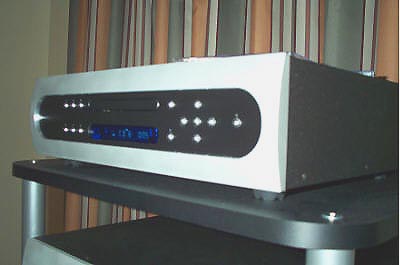 |
||||||||||
Bel Canto's broadly grinning John Stronczer [below left] wins the Tricky Dicky award for delivering a fully functioning universal CD/CD-R/CD-RW/SACD/DVD/DVD-A/MP3 player to CES without any of his comrades in crime knowing about it. This included his own dad and export guru Mike McCormick [right]. "We'll merely do a static display" is all anyone knew. Until showtime. Is that why boss Stronczer grins while McCormick looks rather intense? At $8,500, Bel Canto's new universal player is based on a fully gutted Pioneer platform and even reads MP3s burned to data-grade CD. It includes fully tricked-out Faroudja video circuitry while the audio portion employs DAC-2 24/192 technology which -- due to massive power supplies and a hotrodded output stage -- apparently even eclipses the well-liked DAC's performance for 16-bit Redbook CD. Using Verity Audio Parsefals and their own eVo2i integrated with WireWorld cabling in the smaller anteroom (the bigger frontal space was devoted to the passive display) produced riveting sound that, in Stronzer's opinion, went beyond most everything they'd done previously at tradeshows. Over at T.H.E. Show meanwhile, Terry Cain of Cain & Cain partied with the Flash Gordon-esque SET creations of Josh Stippich of Electronluv previously introduced in our industry features pages. I whipped out a Techno CDs, cranked up the volume, hesitated and glanced worringly at young Josh. He merely chuckled and grinned broadly indicating that the levels and materials were right up his alley. Halleluja, another room that appreciated unrespectable music. The single- and double-horn Fostex-based BENs with optional supertweeter made music with that crystalline immediacy that's the hallmark of the best SETs and minimal crossover speakers. I received an unexpected post-show e-mail from Ultra Audio's Jerry Kindela. He had visited the same exhibit at a different time. It had so impressed him that he was jokingly wondering whether he should now chuck he-man powered monster amps and expensive multi-driver speakers to follow the gospel of the micro-power horn brigade. This only confirms how even "mainstream" audiophiles can relate to the special magic that occurs when low-power zero feedback triodes find their copasetic speaker mates. |
||||||||||
 |
||||||||||
 |
||||||||||
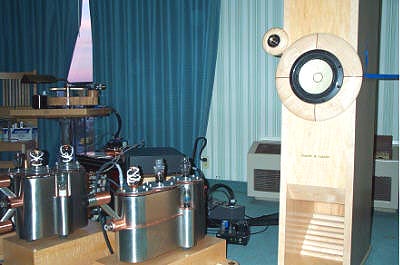 |
||||||||||
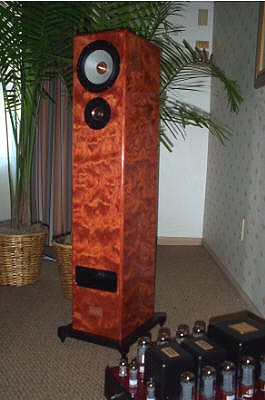 |
||||||||||
 |
||||||||||
Back at the Alexis Park, that other triode master, Dennis Had of Cary Audio, expressed his -- unconfessed and only visible to an insider -- regret at having sold Soliloquy to Raleigh's Bernie Byers who since sold it to Dave Berman. He re-issued his original Soliloquy Model 5.2 tuned-pipe design in the new SIlver Oak loudspeaker ($6,000/pr). Using a SEAS Millenium tweeter and Excel 6.5" magnesium-cone midrange/woofer for 38Hz claimed bass extension, 88dB efficiency and a benign 7-11 ohm load, the Silver Oak measures 42" tall by 8.5" wide by 11" deep and comes in Lace Wood veneer under 7 coats of hand-polished lacquer. Moral of this story? Old loves die hard. |
||||||||||
 |
 |
|||||||||
 |
||||||||||